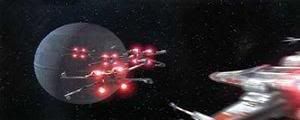Post by Jedibrian on Aug 20, 2010 16:25:09 GMT -5
I would love to see this be for real!

In the future, business meetings might seem like a scene out of the movie, "Star Wars," if technology envisioned at HP comes to fruition.
Stars Wars-like 3D projection technology is on the drawing board at the company, with the potential to project business persons at many locations into virtual reality-like meetings without them having to hop on airplanes and spend significant time away from home.
"The whole concept behind how do you project somebody into the room is really, you have people who are scattered around the country but how do you recreate them so that they feel like they're part of the room," said Phil McKinney, CTO for the Personal Systems Group at HP, at the Emerging Display Technologies Conference on Thursday in San Jose, Calif. This capability can be done in a low-resolution format today but HP is pondering next-generation scenarios.
When the movie "Star Wars" came out in 1977, a critical scene had R2D2, one of hero Luke Skywalker's robot helpers, project a holographic image of heroine Princess Leia putting out a distress call. 3D projections like what is eyed by HP would be made possible by advancements in RGB (red green blue) lasers, McKinney said.
This sort of display technology is "still years out," he said. But as a forerunner, HP with its HP Halo rooms already is able to conduct meetings featuring high-definition video collaboration capabilities, McKinney said. HP Halo technology features "telepresence" and video conferencing.
Step one in HP's vision would be an in-room experience. Subsequently, participants would be able to move out of the room, McKinney said.
Also, McKinney noted HP's work in developing flexible displays, which are made out of mylar film. Users eventually could fashion a display out of an entire wall or desk surfaces, McKinney said. Full color and multi-touch capabilities are part of the effort, he said. Full video would be offered as well. Commercial products based on the technology are anticipated in two to three years.
Article Link

In the future, business meetings might seem like a scene out of the movie, "Star Wars," if technology envisioned at HP comes to fruition.
Stars Wars-like 3D projection technology is on the drawing board at the company, with the potential to project business persons at many locations into virtual reality-like meetings without them having to hop on airplanes and spend significant time away from home.
"The whole concept behind how do you project somebody into the room is really, you have people who are scattered around the country but how do you recreate them so that they feel like they're part of the room," said Phil McKinney, CTO for the Personal Systems Group at HP, at the Emerging Display Technologies Conference on Thursday in San Jose, Calif. This capability can be done in a low-resolution format today but HP is pondering next-generation scenarios.
When the movie "Star Wars" came out in 1977, a critical scene had R2D2, one of hero Luke Skywalker's robot helpers, project a holographic image of heroine Princess Leia putting out a distress call. 3D projections like what is eyed by HP would be made possible by advancements in RGB (red green blue) lasers, McKinney said.
This sort of display technology is "still years out," he said. But as a forerunner, HP with its HP Halo rooms already is able to conduct meetings featuring high-definition video collaboration capabilities, McKinney said. HP Halo technology features "telepresence" and video conferencing.
Step one in HP's vision would be an in-room experience. Subsequently, participants would be able to move out of the room, McKinney said.
Also, McKinney noted HP's work in developing flexible displays, which are made out of mylar film. Users eventually could fashion a display out of an entire wall or desk surfaces, McKinney said. Full color and multi-touch capabilities are part of the effort, he said. Full video would be offered as well. Commercial products based on the technology are anticipated in two to three years.
Article Link




